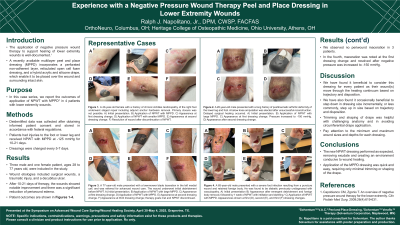Case Series/Study
(CS-106) Experience with a Negative Pressure Wound Therapy Peel and Place Dressing in Lower Extremity Wounds
Friday, May 2, 2025
7:45 PM - 8:45 PM East Coast USA Time

Introduction: The application of negative pressure wound therapy (NPWT) to support healing of lower extremity wounds is well-documented.1 A multilayer peel and place dressing (MPPD), has recently become available for use with NPWT. The MPPD incorporates a perforated non-adherent layer, reticulated open cell foam dressing, and a hybrid acrylic and silicone drape, which simplify its application over the wound and surrounding intact skin. We report the outcomes of application of NPWT with MPPD in 4 patients with lower extremity wounds.
Methods: Deidentified data was collected after obtaining informed patient consent and stored in accordance with federal regulations. Patients had injuries to the foot or lower leg and received NPWT with MPPD at -125 mmHg for 10 days, with dressing changes conducted on day 5.
Results: This study included two male and two female patients between the ages of 40 to 80 years. Wound etiologies included surgical wounds, a traumatic injury, and a decubitus ulcer. After 10 days of therapy, the wounds showed notable improvement and there was a significant reduction of periwound edema. For 3 patients, there was no periwound maceration; in 1 patient, maceration was noted at the first dressing change and resolved after negative pressure was increased to 150 mmHg.
Discussion: The MPPD dressing performed as expected, removing exudate and creating an environment conducive to wound healing. Application of the MPPD dressing was quick and easy, requiring only minimal trimming or shaping of the drape.
Methods: Deidentified data was collected after obtaining informed patient consent and stored in accordance with federal regulations. Patients had injuries to the foot or lower leg and received NPWT with MPPD at -125 mmHg for 10 days, with dressing changes conducted on day 5.
Results: This study included two male and two female patients between the ages of 40 to 80 years. Wound etiologies included surgical wounds, a traumatic injury, and a decubitus ulcer. After 10 days of therapy, the wounds showed notable improvement and there was a significant reduction of periwound edema. For 3 patients, there was no periwound maceration; in 1 patient, maceration was noted at the first dressing change and resolved after negative pressure was increased to 150 mmHg.
Discussion: The MPPD dressing performed as expected, removing exudate and creating an environment conducive to wound healing. Application of the MPPD dressing was quick and easy, requiring only minimal trimming or shaping of the drape.

.jpg)
